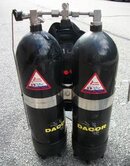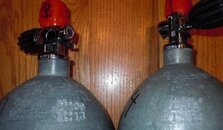There are a few potential issues.
As noted above, these tanks have sat unused a long, long time. If they had a moist fill and then were exposed to hot and cold cycles (such as stored in garage in cold winters) condensation could have resulted in enough rust to cause a pit inside the tank and that's what kills most steel tanks.
Also, US Divers and other companies sourced tanks from PST and then had an internal coating applied. This was usually a light brown or tan epoxy coating and the intent was to seal the inner surface from moisture to prevent rust. It worked, well, until the liner cracked or developed pin holes. Those defects then let water in between the liner and the tank, resulting in rust, and worse made it hard to spot early in the process.
As a result no one with any knowledge of the issue will pass a steel 72 with an epoxy liner. It can be removed but you'll need to dry tumble the tank with an aggressive oxide media for about a week to remove it. If you don't have your own tank tumbler, you'll need a sympathetic shop that won't charge you an arm and a leg. Even then, once the liner is removed, you may find a rust pit that will condemn the tank.
A third issue was the practice of dip coating tanks with a thick outer coating much like the plasticote coating on tool handles. It worked fine until the coating was compromised, at which point it would hold water against the steel. And once again a qualified inspector won't requalify the tank as the coating prevents proper inspection of the tank. It can be removed with a can pf paint stripper, a plastic scraper and some elbow grease.
What you'll find underneath however will vary. If the tank is galvanized you'll probably have a great tank with nearly new looking galvanizing. If the tank is not, you'll either have rust pits and a wind chime, or you'll have an ungalvanized tank prone to rust unless you paint it. Paint is hard to maintain on a scuba tank, even if you use Imron or some other expensive finish. Your best results will be with ZRC cold galvanizing compound, but it's expensive at about $60 per quart.
Consequently, I would not offer anything for the tank unless you can either:
1. look inside to verify there is no liner, no rust and no pitting, or
2. get assurance that you can get your money back if it won't pass a requalification (which includes both a VIP and a hydro test).
Steel 72s are becoming more popular as they are a superb side mount tank. However, they are also a bit a of an oddity given that as a 3AA steel tank they have essentially no life limit if properly maintained 0 but as steel tanks that haven't been made since the late 1970s, they are all old enough that you have to worry about how well they've been cared for.
Consequently, in current hydro and with a current VIP, I'd happily pay $100-$150 each for a galvanized steel 72. However, for an unknown steel $72 I won't pay more than scrap metal value, as the cost of tumbling to remove any accumulated rust and/or a liner followed by requalification can run $50-$75, and then there's no guaranteed it will pass.
----
I don't worry about plus ratings on steel tanks. It's hard to find a RIN that will plus rate any steel tank, even if you have proper documentation from the manufacturer, as most are too lazy to do the extra calculation and paperwork. You can't get a plus rating on a Exempt or Special Permit steel tank and my other steel tanks al get cave filled anyway.
Most shops in cave country will still fill a properly certified steel 72 in good condition to 3000 psi (short of the 3375 psi that would be equivalent to a 3600 psi fill in a 2400 psi tank, but it's still 86 cu ft), and I normally fill mine to 2800 psi off my compressor, which is 80.5 cu ft.






